BSBLED805: Coaching Scenario - Planning a Mentoring Process Report
VerifiedAdded on 2022/10/15
|10
|2397
|198
Report
AI Summary
This report presents a detailed plan for a mentoring program within a specific coaching scenario, as outlined in the BSBLED805 assignment. The report begins by outlining the key steps involved in the mentoring process, including goal setting, reality checks, feedback and discussion, options, and a way forward. It then provides an academic justification for the chosen modes (face-to-face and online mentoring) and methods, emphasizing the importance of internal communication, relationship development, and addressing factors such as employee contribution, organizational co-operation, problem-solving skills, and self-learning. The report also explores the application of Kolb's Learning Styles model to guide the mentoring approach, ensuring that employees can effectively learn and implement new strategies. References are provided to support the analysis and recommendations.
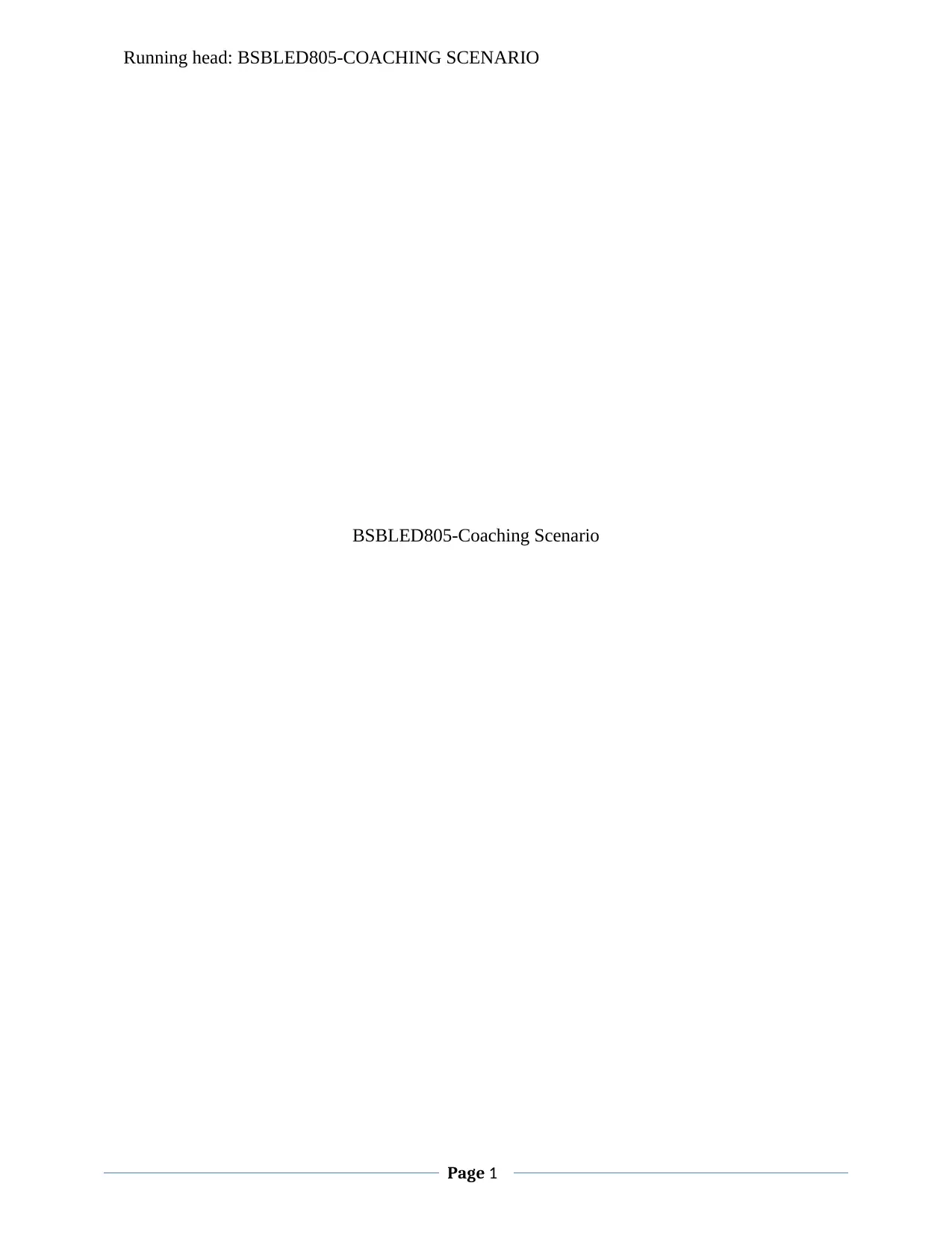
Running head: BSBLED805-COACHING SCENARIO
BSBLED805-Coaching Scenario
Page 1
BSBLED805-Coaching Scenario
Page 1
Paraphrase This Document
Need a fresh take? Get an instant paraphrase of this document with our AI Paraphraser
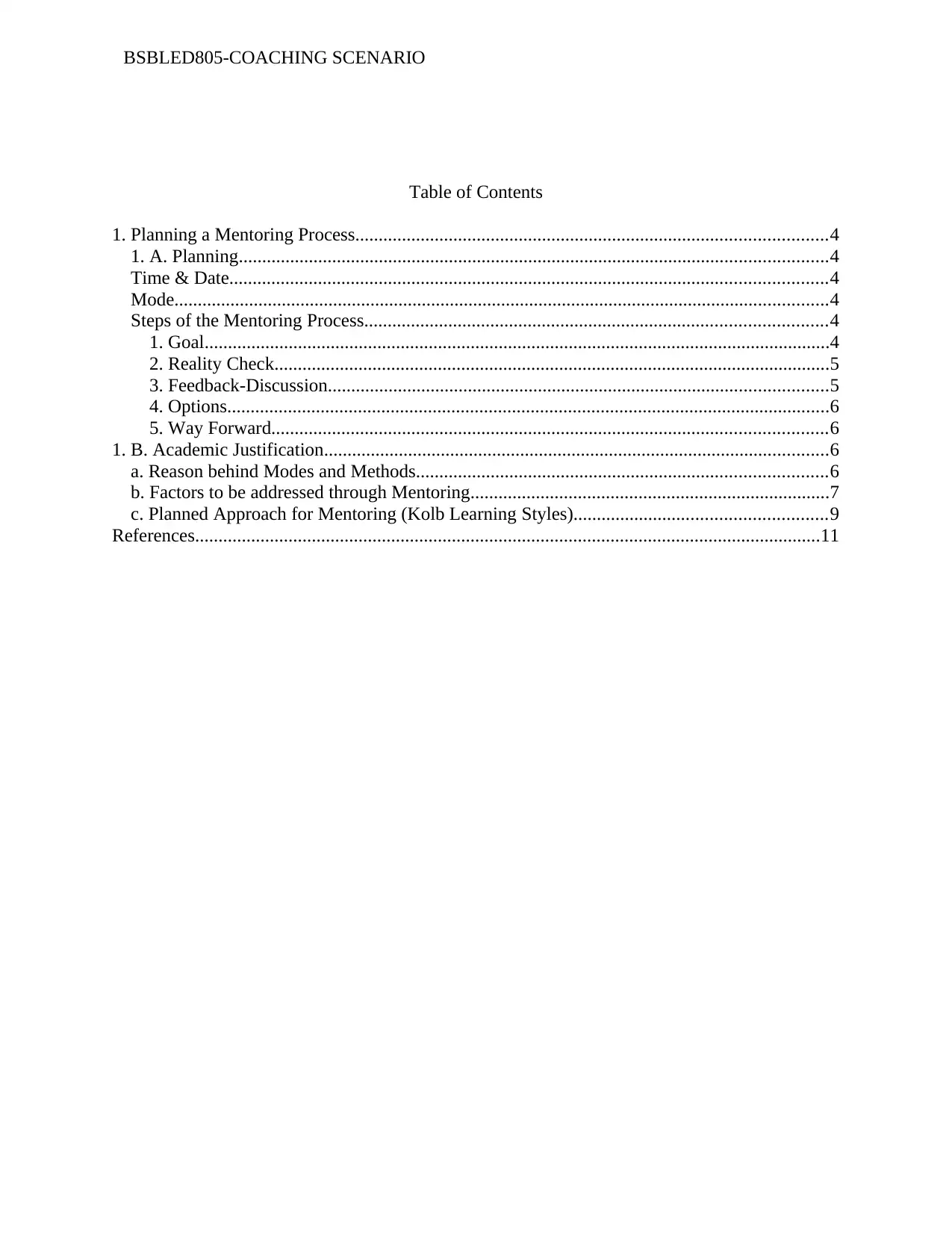
BSBLED805-COACHING SCENARIO
Table of Contents
1. Planning a Mentoring Process.....................................................................................................4
1. A. Planning..............................................................................................................................4
Time & Date................................................................................................................................4
Mode............................................................................................................................................4
Steps of the Mentoring Process...................................................................................................4
1. Goal......................................................................................................................................4
2. Reality Check.......................................................................................................................5
3. Feedback-Discussion...........................................................................................................5
4. Options.................................................................................................................................6
5. Way Forward.......................................................................................................................6
1. B. Academic Justification............................................................................................................6
a. Reason behind Modes and Methods........................................................................................6
b. Factors to be addressed through Mentoring.............................................................................7
c. Planned Approach for Mentoring (Kolb Learning Styles)......................................................9
References......................................................................................................................................11
Table of Contents
1. Planning a Mentoring Process.....................................................................................................4
1. A. Planning..............................................................................................................................4
Time & Date................................................................................................................................4
Mode............................................................................................................................................4
Steps of the Mentoring Process...................................................................................................4
1. Goal......................................................................................................................................4
2. Reality Check.......................................................................................................................5
3. Feedback-Discussion...........................................................................................................5
4. Options.................................................................................................................................6
5. Way Forward.......................................................................................................................6
1. B. Academic Justification............................................................................................................6
a. Reason behind Modes and Methods........................................................................................6
b. Factors to be addressed through Mentoring.............................................................................7
c. Planned Approach for Mentoring (Kolb Learning Styles)......................................................9
References......................................................................................................................................11
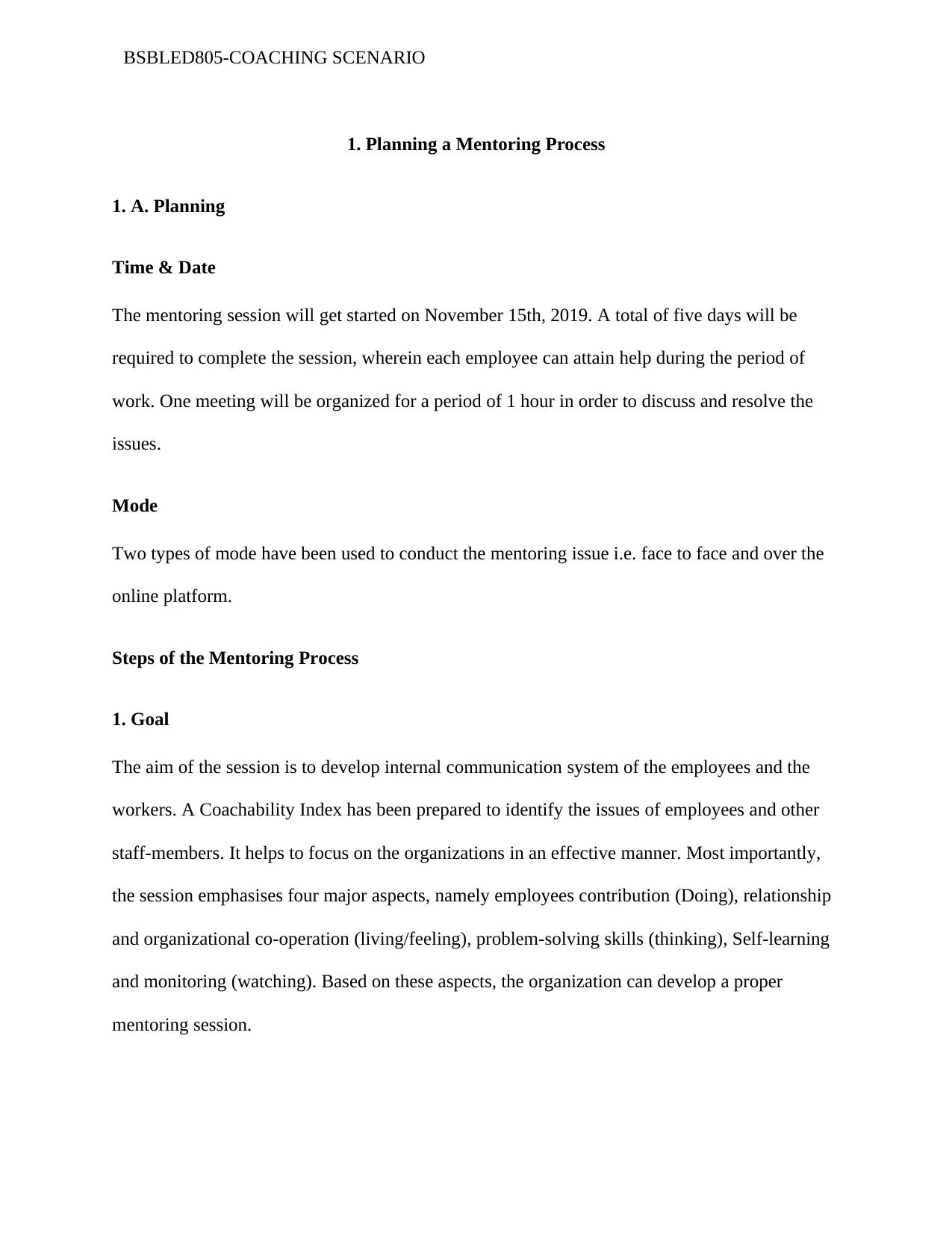
BSBLED805-COACHING SCENARIO
1. Planning a Mentoring Process
1. A. Planning
Time & Date
The mentoring session will get started on November 15th, 2019. A total of five days will be
required to complete the session, wherein each employee can attain help during the period of
work. One meeting will be organized for a period of 1 hour in order to discuss and resolve the
issues.
Mode
Two types of mode have been used to conduct the mentoring issue i.e. face to face and over the
online platform.
Steps of the Mentoring Process
1. Goal
The aim of the session is to develop internal communication system of the employees and the
workers. A Coachability Index has been prepared to identify the issues of employees and other
staff-members. It helps to focus on the organizations in an effective manner. Most importantly,
the session emphasises four major aspects, namely employees contribution (Doing), relationship
and organizational co-operation (living/feeling), problem-solving skills (thinking), Self-learning
and monitoring (watching). Based on these aspects, the organization can develop a proper
mentoring session.
1. Planning a Mentoring Process
1. A. Planning
Time & Date
The mentoring session will get started on November 15th, 2019. A total of five days will be
required to complete the session, wherein each employee can attain help during the period of
work. One meeting will be organized for a period of 1 hour in order to discuss and resolve the
issues.
Mode
Two types of mode have been used to conduct the mentoring issue i.e. face to face and over the
online platform.
Steps of the Mentoring Process
1. Goal
The aim of the session is to develop internal communication system of the employees and the
workers. A Coachability Index has been prepared to identify the issues of employees and other
staff-members. It helps to focus on the organizations in an effective manner. Most importantly,
the session emphasises four major aspects, namely employees contribution (Doing), relationship
and organizational co-operation (living/feeling), problem-solving skills (thinking), Self-learning
and monitoring (watching). Based on these aspects, the organization can develop a proper
mentoring session.
⊘ This is a preview!⊘
Do you want full access?
Subscribe today to unlock all pages.

Trusted by 1+ million students worldwide
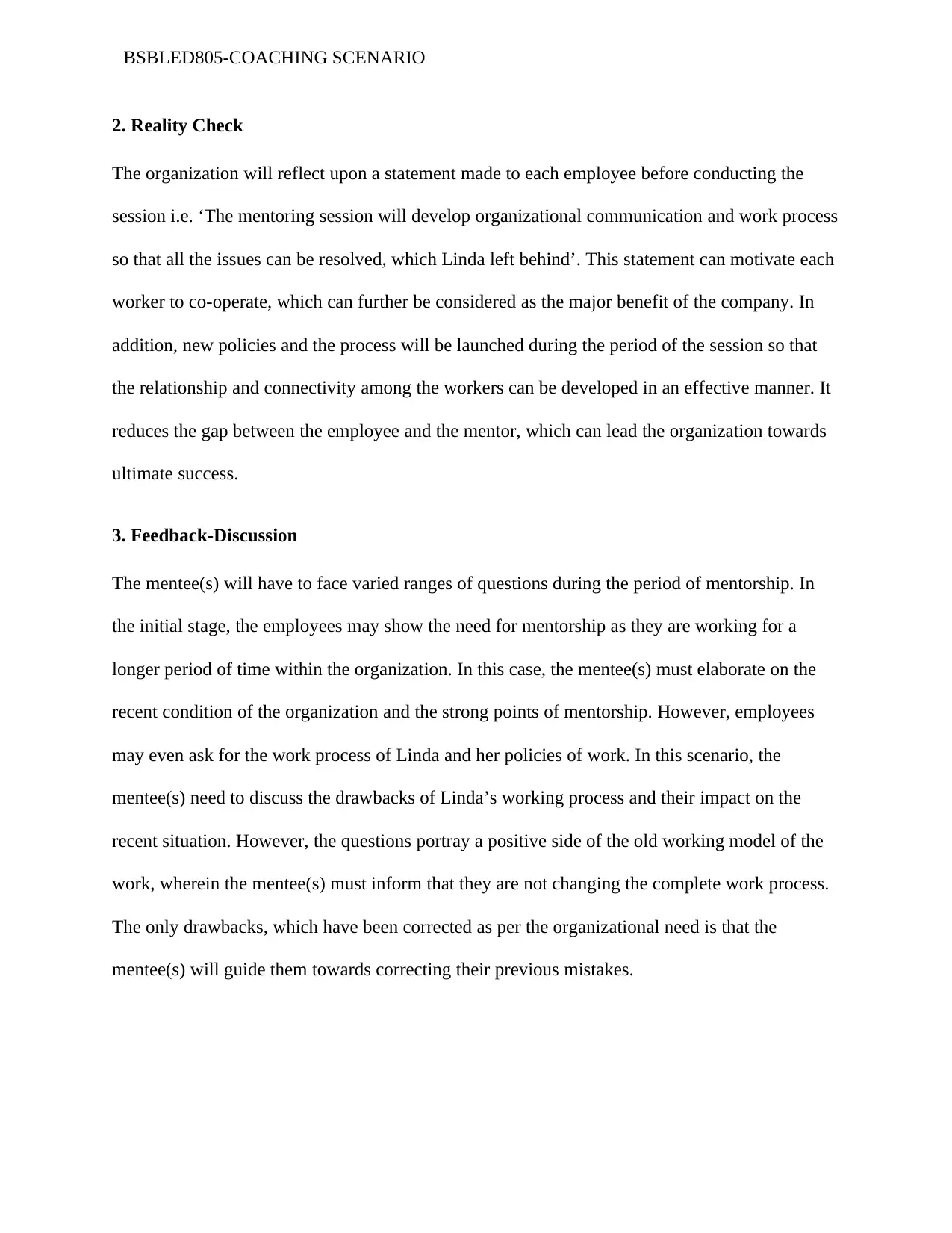
BSBLED805-COACHING SCENARIO
2. Reality Check
The organization will reflect upon a statement made to each employee before conducting the
session i.e. ‘The mentoring session will develop organizational communication and work process
so that all the issues can be resolved, which Linda left behind’. This statement can motivate each
worker to co-operate, which can further be considered as the major benefit of the company. In
addition, new policies and the process will be launched during the period of the session so that
the relationship and connectivity among the workers can be developed in an effective manner. It
reduces the gap between the employee and the mentor, which can lead the organization towards
ultimate success.
3. Feedback-Discussion
The mentee(s) will have to face varied ranges of questions during the period of mentorship. In
the initial stage, the employees may show the need for mentorship as they are working for a
longer period of time within the organization. In this case, the mentee(s) must elaborate on the
recent condition of the organization and the strong points of mentorship. However, employees
may even ask for the work process of Linda and her policies of work. In this scenario, the
mentee(s) need to discuss the drawbacks of Linda’s working process and their impact on the
recent situation. However, the questions portray a positive side of the old working model of the
work, wherein the mentee(s) must inform that they are not changing the complete work process.
The only drawbacks, which have been corrected as per the organizational need is that the
mentee(s) will guide them towards correcting their previous mistakes.
2. Reality Check
The organization will reflect upon a statement made to each employee before conducting the
session i.e. ‘The mentoring session will develop organizational communication and work process
so that all the issues can be resolved, which Linda left behind’. This statement can motivate each
worker to co-operate, which can further be considered as the major benefit of the company. In
addition, new policies and the process will be launched during the period of the session so that
the relationship and connectivity among the workers can be developed in an effective manner. It
reduces the gap between the employee and the mentor, which can lead the organization towards
ultimate success.
3. Feedback-Discussion
The mentee(s) will have to face varied ranges of questions during the period of mentorship. In
the initial stage, the employees may show the need for mentorship as they are working for a
longer period of time within the organization. In this case, the mentee(s) must elaborate on the
recent condition of the organization and the strong points of mentorship. However, employees
may even ask for the work process of Linda and her policies of work. In this scenario, the
mentee(s) need to discuss the drawbacks of Linda’s working process and their impact on the
recent situation. However, the questions portray a positive side of the old working model of the
work, wherein the mentee(s) must inform that they are not changing the complete work process.
The only drawbacks, which have been corrected as per the organizational need is that the
mentee(s) will guide them towards correcting their previous mistakes.
Paraphrase This Document
Need a fresh take? Get an instant paraphrase of this document with our AI Paraphraser
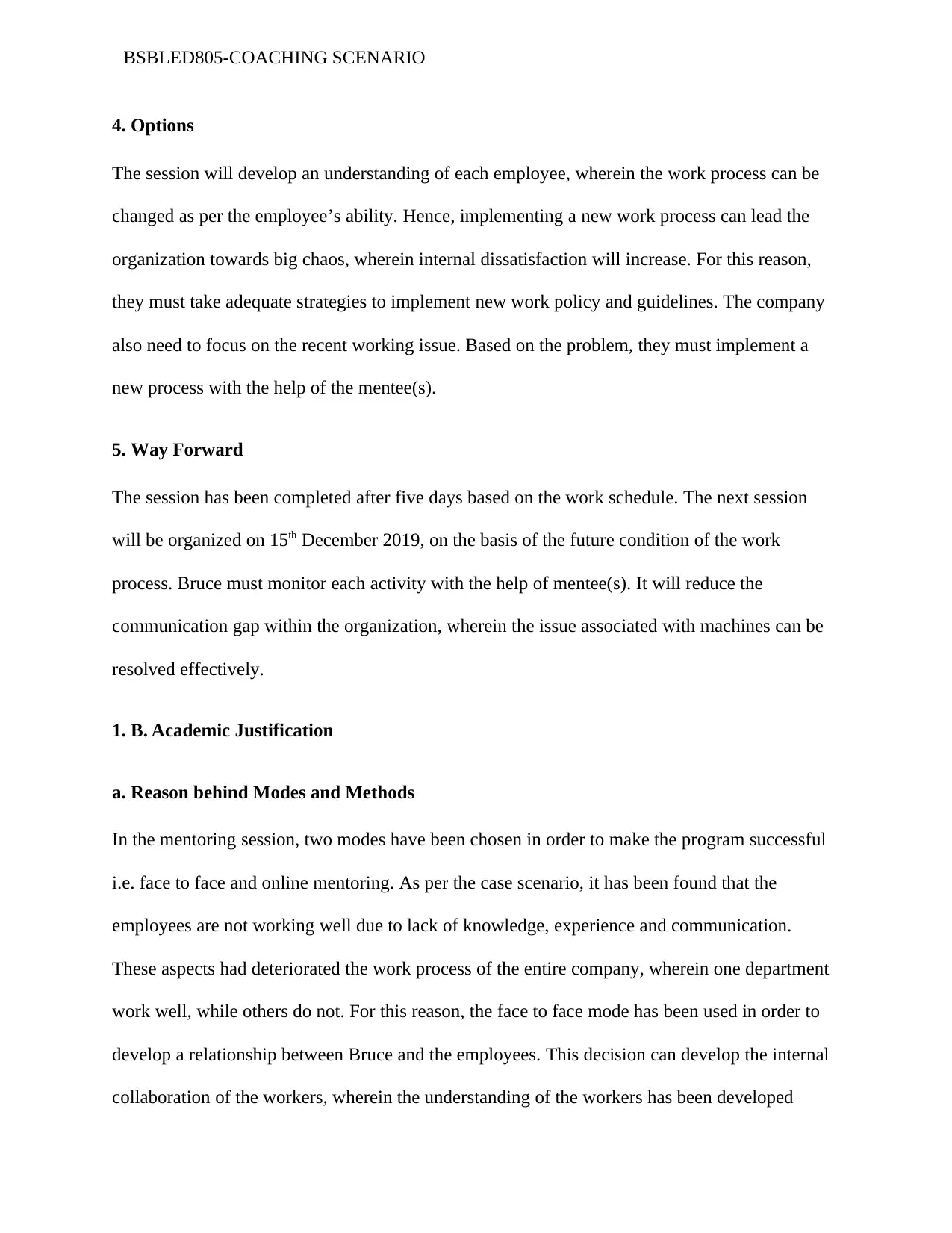
BSBLED805-COACHING SCENARIO
4. Options
The session will develop an understanding of each employee, wherein the work process can be
changed as per the employee’s ability. Hence, implementing a new work process can lead the
organization towards big chaos, wherein internal dissatisfaction will increase. For this reason,
they must take adequate strategies to implement new work policy and guidelines. The company
also need to focus on the recent working issue. Based on the problem, they must implement a
new process with the help of the mentee(s).
5. Way Forward
The session has been completed after five days based on the work schedule. The next session
will be organized on 15th December 2019, on the basis of the future condition of the work
process. Bruce must monitor each activity with the help of mentee(s). It will reduce the
communication gap within the organization, wherein the issue associated with machines can be
resolved effectively.
1. B. Academic Justification
a. Reason behind Modes and Methods
In the mentoring session, two modes have been chosen in order to make the program successful
i.e. face to face and online mentoring. As per the case scenario, it has been found that the
employees are not working well due to lack of knowledge, experience and communication.
These aspects had deteriorated the work process of the entire company, wherein one department
work well, while others do not. For this reason, the face to face mode has been used in order to
develop a relationship between Bruce and the employees. This decision can develop the internal
collaboration of the workers, wherein the understanding of the workers has been developed
4. Options
The session will develop an understanding of each employee, wherein the work process can be
changed as per the employee’s ability. Hence, implementing a new work process can lead the
organization towards big chaos, wherein internal dissatisfaction will increase. For this reason,
they must take adequate strategies to implement new work policy and guidelines. The company
also need to focus on the recent working issue. Based on the problem, they must implement a
new process with the help of the mentee(s).
5. Way Forward
The session has been completed after five days based on the work schedule. The next session
will be organized on 15th December 2019, on the basis of the future condition of the work
process. Bruce must monitor each activity with the help of mentee(s). It will reduce the
communication gap within the organization, wherein the issue associated with machines can be
resolved effectively.
1. B. Academic Justification
a. Reason behind Modes and Methods
In the mentoring session, two modes have been chosen in order to make the program successful
i.e. face to face and online mentoring. As per the case scenario, it has been found that the
employees are not working well due to lack of knowledge, experience and communication.
These aspects had deteriorated the work process of the entire company, wherein one department
work well, while others do not. For this reason, the face to face mode has been used in order to
develop a relationship between Bruce and the employees. This decision can develop the internal
collaboration of the workers, wherein the understanding of the workers has been developed
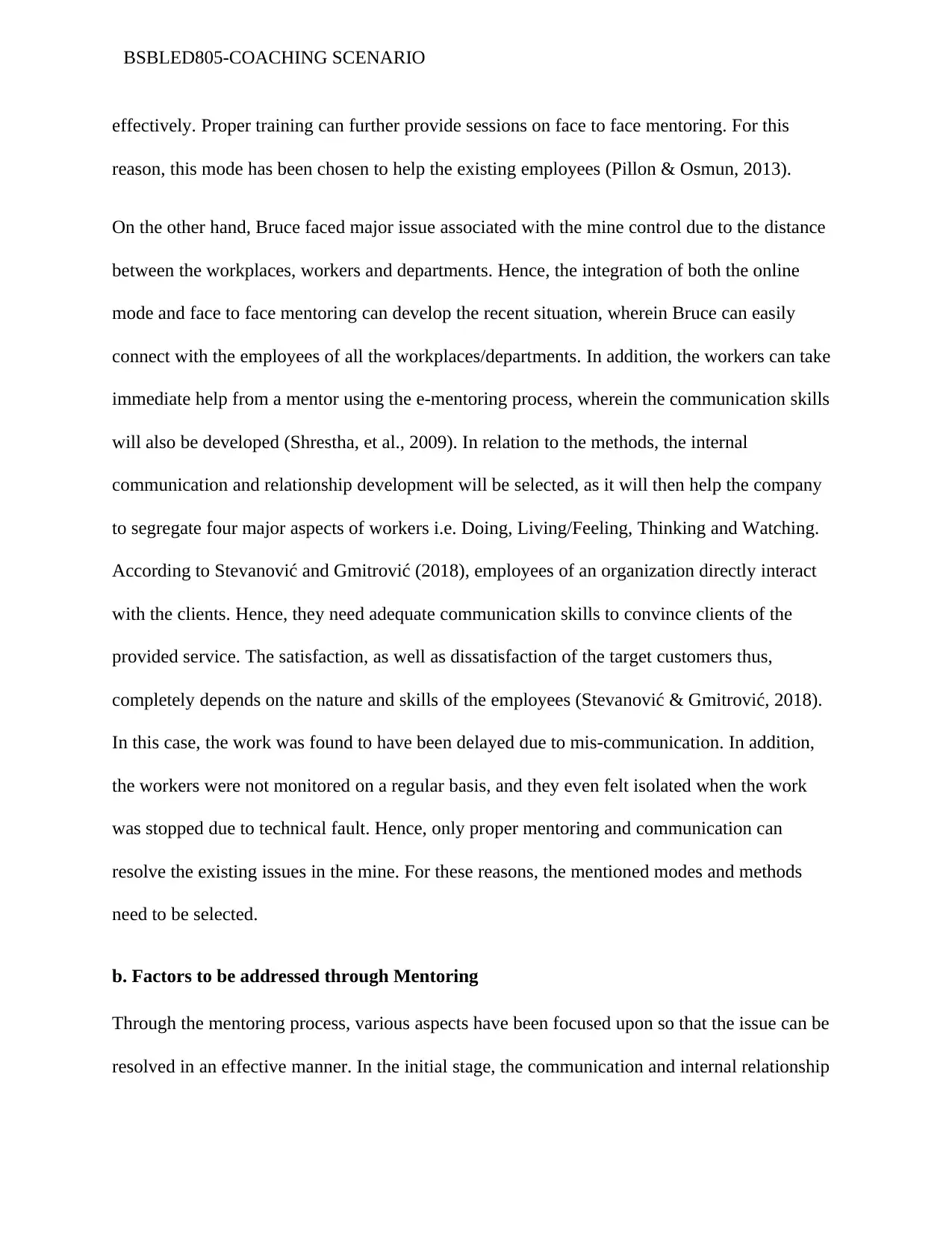
BSBLED805-COACHING SCENARIO
effectively. Proper training can further provide sessions on face to face mentoring. For this
reason, this mode has been chosen to help the existing employees (Pillon & Osmun, 2013).
On the other hand, Bruce faced major issue associated with the mine control due to the distance
between the workplaces, workers and departments. Hence, the integration of both the online
mode and face to face mentoring can develop the recent situation, wherein Bruce can easily
connect with the employees of all the workplaces/departments. In addition, the workers can take
immediate help from a mentor using the e-mentoring process, wherein the communication skills
will also be developed (Shrestha, et al., 2009). In relation to the methods, the internal
communication and relationship development will be selected, as it will then help the company
to segregate four major aspects of workers i.e. Doing, Living/Feeling, Thinking and Watching.
According to Stevanović and Gmitrović (2018), employees of an organization directly interact
with the clients. Hence, they need adequate communication skills to convince clients of the
provided service. The satisfaction, as well as dissatisfaction of the target customers thus,
completely depends on the nature and skills of the employees (Stevanović & Gmitrović, 2018).
In this case, the work was found to have been delayed due to mis-communication. In addition,
the workers were not monitored on a regular basis, and they even felt isolated when the work
was stopped due to technical fault. Hence, only proper mentoring and communication can
resolve the existing issues in the mine. For these reasons, the mentioned modes and methods
need to be selected.
b. Factors to be addressed through Mentoring
Through the mentoring process, various aspects have been focused upon so that the issue can be
resolved in an effective manner. In the initial stage, the communication and internal relationship
effectively. Proper training can further provide sessions on face to face mentoring. For this
reason, this mode has been chosen to help the existing employees (Pillon & Osmun, 2013).
On the other hand, Bruce faced major issue associated with the mine control due to the distance
between the workplaces, workers and departments. Hence, the integration of both the online
mode and face to face mentoring can develop the recent situation, wherein Bruce can easily
connect with the employees of all the workplaces/departments. In addition, the workers can take
immediate help from a mentor using the e-mentoring process, wherein the communication skills
will also be developed (Shrestha, et al., 2009). In relation to the methods, the internal
communication and relationship development will be selected, as it will then help the company
to segregate four major aspects of workers i.e. Doing, Living/Feeling, Thinking and Watching.
According to Stevanović and Gmitrović (2018), employees of an organization directly interact
with the clients. Hence, they need adequate communication skills to convince clients of the
provided service. The satisfaction, as well as dissatisfaction of the target customers thus,
completely depends on the nature and skills of the employees (Stevanović & Gmitrović, 2018).
In this case, the work was found to have been delayed due to mis-communication. In addition,
the workers were not monitored on a regular basis, and they even felt isolated when the work
was stopped due to technical fault. Hence, only proper mentoring and communication can
resolve the existing issues in the mine. For these reasons, the mentioned modes and methods
need to be selected.
b. Factors to be addressed through Mentoring
Through the mentoring process, various aspects have been focused upon so that the issue can be
resolved in an effective manner. In the initial stage, the communication and internal relationship
⊘ This is a preview!⊘
Do you want full access?
Subscribe today to unlock all pages.

Trusted by 1+ million students worldwide
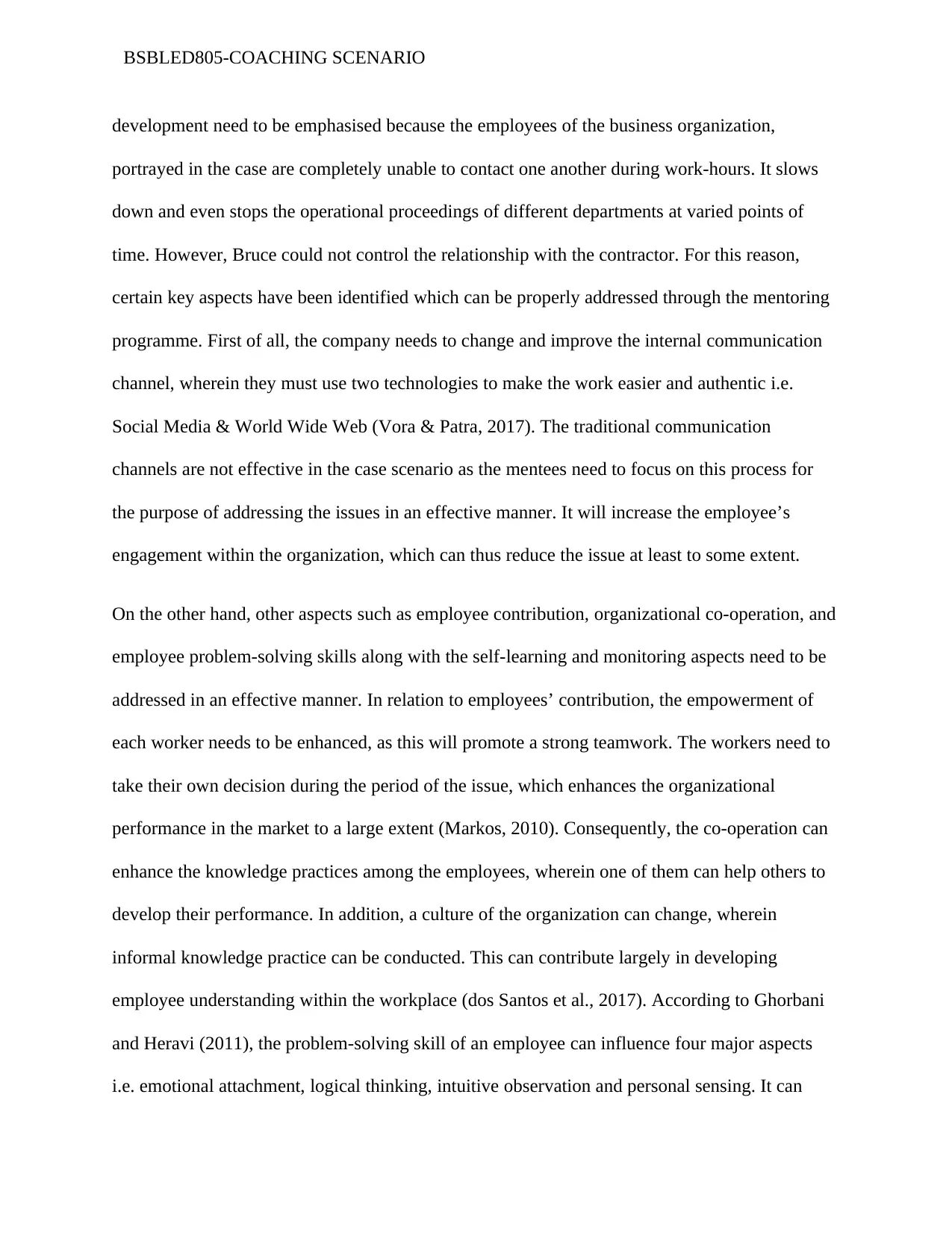
BSBLED805-COACHING SCENARIO
development need to be emphasised because the employees of the business organization,
portrayed in the case are completely unable to contact one another during work-hours. It slows
down and even stops the operational proceedings of different departments at varied points of
time. However, Bruce could not control the relationship with the contractor. For this reason,
certain key aspects have been identified which can be properly addressed through the mentoring
programme. First of all, the company needs to change and improve the internal communication
channel, wherein they must use two technologies to make the work easier and authentic i.e.
Social Media & World Wide Web (Vora & Patra, 2017). The traditional communication
channels are not effective in the case scenario as the mentees need to focus on this process for
the purpose of addressing the issues in an effective manner. It will increase the employee’s
engagement within the organization, which can thus reduce the issue at least to some extent.
On the other hand, other aspects such as employee contribution, organizational co-operation, and
employee problem-solving skills along with the self-learning and monitoring aspects need to be
addressed in an effective manner. In relation to employees’ contribution, the empowerment of
each worker needs to be enhanced, as this will promote a strong teamwork. The workers need to
take their own decision during the period of the issue, which enhances the organizational
performance in the market to a large extent (Markos, 2010). Consequently, the co-operation can
enhance the knowledge practices among the employees, wherein one of them can help others to
develop their performance. In addition, a culture of the organization can change, wherein
informal knowledge practice can be conducted. This can contribute largely in developing
employee understanding within the workplace (dos Santos et al., 2017). According to Ghorbani
and Heravi (2011), the problem-solving skill of an employee can influence four major aspects
i.e. emotional attachment, logical thinking, intuitive observation and personal sensing. It can
development need to be emphasised because the employees of the business organization,
portrayed in the case are completely unable to contact one another during work-hours. It slows
down and even stops the operational proceedings of different departments at varied points of
time. However, Bruce could not control the relationship with the contractor. For this reason,
certain key aspects have been identified which can be properly addressed through the mentoring
programme. First of all, the company needs to change and improve the internal communication
channel, wherein they must use two technologies to make the work easier and authentic i.e.
Social Media & World Wide Web (Vora & Patra, 2017). The traditional communication
channels are not effective in the case scenario as the mentees need to focus on this process for
the purpose of addressing the issues in an effective manner. It will increase the employee’s
engagement within the organization, which can thus reduce the issue at least to some extent.
On the other hand, other aspects such as employee contribution, organizational co-operation, and
employee problem-solving skills along with the self-learning and monitoring aspects need to be
addressed in an effective manner. In relation to employees’ contribution, the empowerment of
each worker needs to be enhanced, as this will promote a strong teamwork. The workers need to
take their own decision during the period of the issue, which enhances the organizational
performance in the market to a large extent (Markos, 2010). Consequently, the co-operation can
enhance the knowledge practices among the employees, wherein one of them can help others to
develop their performance. In addition, a culture of the organization can change, wherein
informal knowledge practice can be conducted. This can contribute largely in developing
employee understanding within the workplace (dos Santos et al., 2017). According to Ghorbani
and Heravi (2011), the problem-solving skill of an employee can influence four major aspects
i.e. emotional attachment, logical thinking, intuitive observation and personal sensing. It can
Paraphrase This Document
Need a fresh take? Get an instant paraphrase of this document with our AI Paraphraser
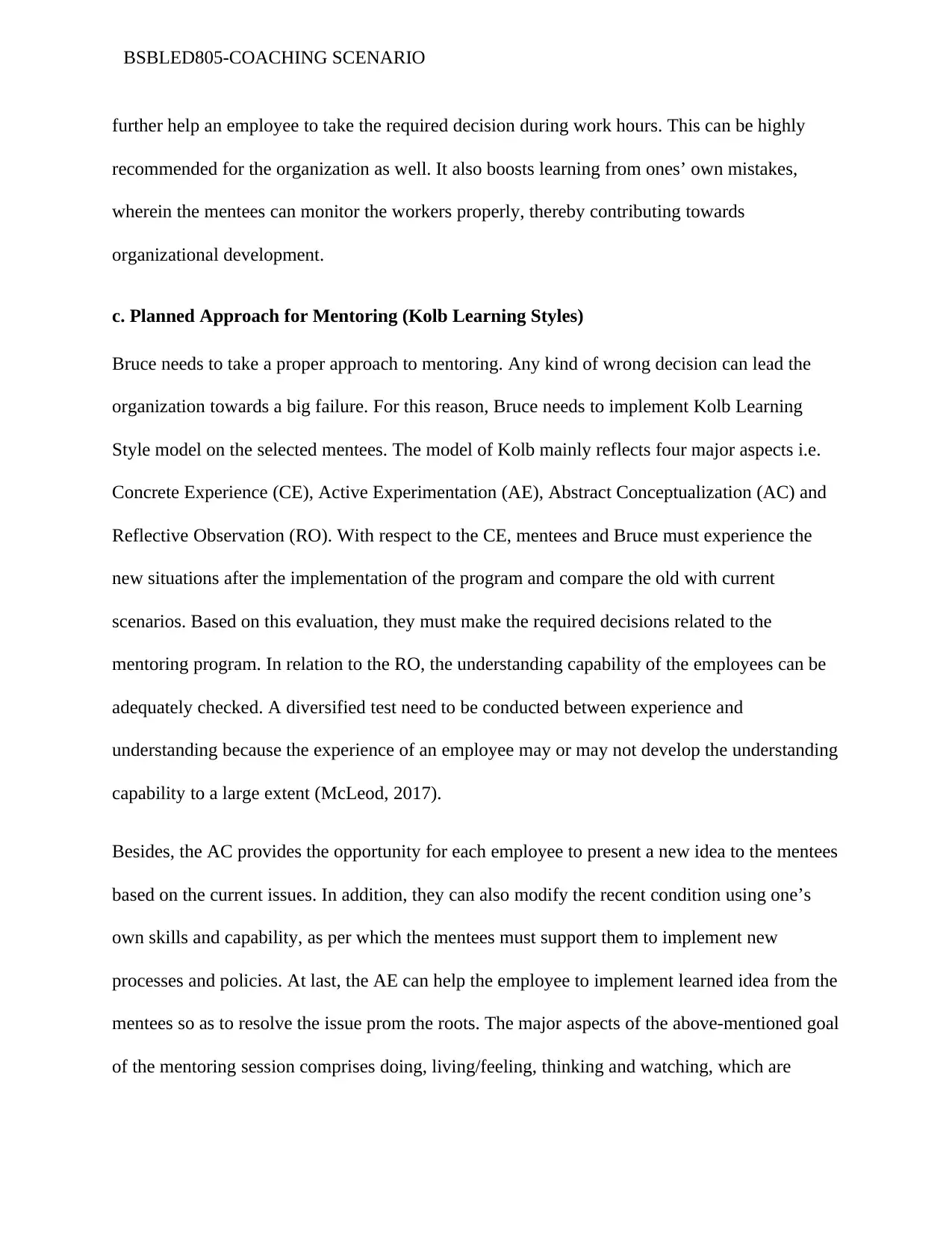
BSBLED805-COACHING SCENARIO
further help an employee to take the required decision during work hours. This can be highly
recommended for the organization as well. It also boosts learning from ones’ own mistakes,
wherein the mentees can monitor the workers properly, thereby contributing towards
organizational development.
c. Planned Approach for Mentoring (Kolb Learning Styles)
Bruce needs to take a proper approach to mentoring. Any kind of wrong decision can lead the
organization towards a big failure. For this reason, Bruce needs to implement Kolb Learning
Style model on the selected mentees. The model of Kolb mainly reflects four major aspects i.e.
Concrete Experience (CE), Active Experimentation (AE), Abstract Conceptualization (AC) and
Reflective Observation (RO). With respect to the CE, mentees and Bruce must experience the
new situations after the implementation of the program and compare the old with current
scenarios. Based on this evaluation, they must make the required decisions related to the
mentoring program. In relation to the RO, the understanding capability of the employees can be
adequately checked. A diversified test need to be conducted between experience and
understanding because the experience of an employee may or may not develop the understanding
capability to a large extent (McLeod, 2017).
Besides, the AC provides the opportunity for each employee to present a new idea to the mentees
based on the current issues. In addition, they can also modify the recent condition using one’s
own skills and capability, as per which the mentees must support them to implement new
processes and policies. At last, the AE can help the employee to implement learned idea from the
mentees so as to resolve the issue prom the roots. The major aspects of the above-mentioned goal
of the mentoring session comprises doing, living/feeling, thinking and watching, which are
further help an employee to take the required decision during work hours. This can be highly
recommended for the organization as well. It also boosts learning from ones’ own mistakes,
wherein the mentees can monitor the workers properly, thereby contributing towards
organizational development.
c. Planned Approach for Mentoring (Kolb Learning Styles)
Bruce needs to take a proper approach to mentoring. Any kind of wrong decision can lead the
organization towards a big failure. For this reason, Bruce needs to implement Kolb Learning
Style model on the selected mentees. The model of Kolb mainly reflects four major aspects i.e.
Concrete Experience (CE), Active Experimentation (AE), Abstract Conceptualization (AC) and
Reflective Observation (RO). With respect to the CE, mentees and Bruce must experience the
new situations after the implementation of the program and compare the old with current
scenarios. Based on this evaluation, they must make the required decisions related to the
mentoring program. In relation to the RO, the understanding capability of the employees can be
adequately checked. A diversified test need to be conducted between experience and
understanding because the experience of an employee may or may not develop the understanding
capability to a large extent (McLeod, 2017).
Besides, the AC provides the opportunity for each employee to present a new idea to the mentees
based on the current issues. In addition, they can also modify the recent condition using one’s
own skills and capability, as per which the mentees must support them to implement new
processes and policies. At last, the AE can help the employee to implement learned idea from the
mentees so as to resolve the issue prom the roots. The major aspects of the above-mentioned goal
of the mentoring session comprises doing, living/feeling, thinking and watching, which are
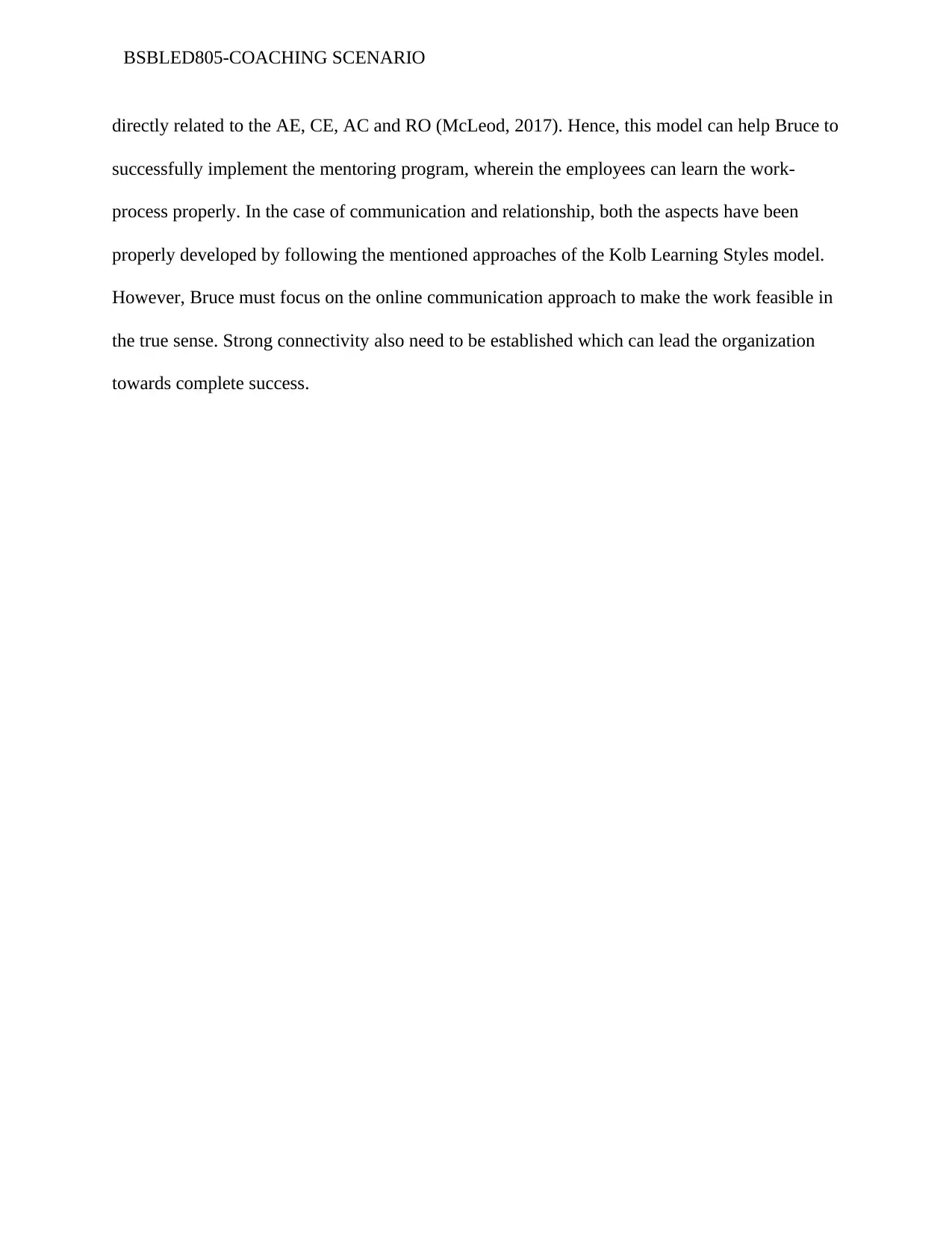
BSBLED805-COACHING SCENARIO
directly related to the AE, CE, AC and RO (McLeod, 2017). Hence, this model can help Bruce to
successfully implement the mentoring program, wherein the employees can learn the work-
process properly. In the case of communication and relationship, both the aspects have been
properly developed by following the mentioned approaches of the Kolb Learning Styles model.
However, Bruce must focus on the online communication approach to make the work feasible in
the true sense. Strong connectivity also need to be established which can lead the organization
towards complete success.
directly related to the AE, CE, AC and RO (McLeod, 2017). Hence, this model can help Bruce to
successfully implement the mentoring program, wherein the employees can learn the work-
process properly. In the case of communication and relationship, both the aspects have been
properly developed by following the mentioned approaches of the Kolb Learning Styles model.
However, Bruce must focus on the online communication approach to make the work feasible in
the true sense. Strong connectivity also need to be established which can lead the organization
towards complete success.
⊘ This is a preview!⊘
Do you want full access?
Subscribe today to unlock all pages.

Trusted by 1+ million students worldwide
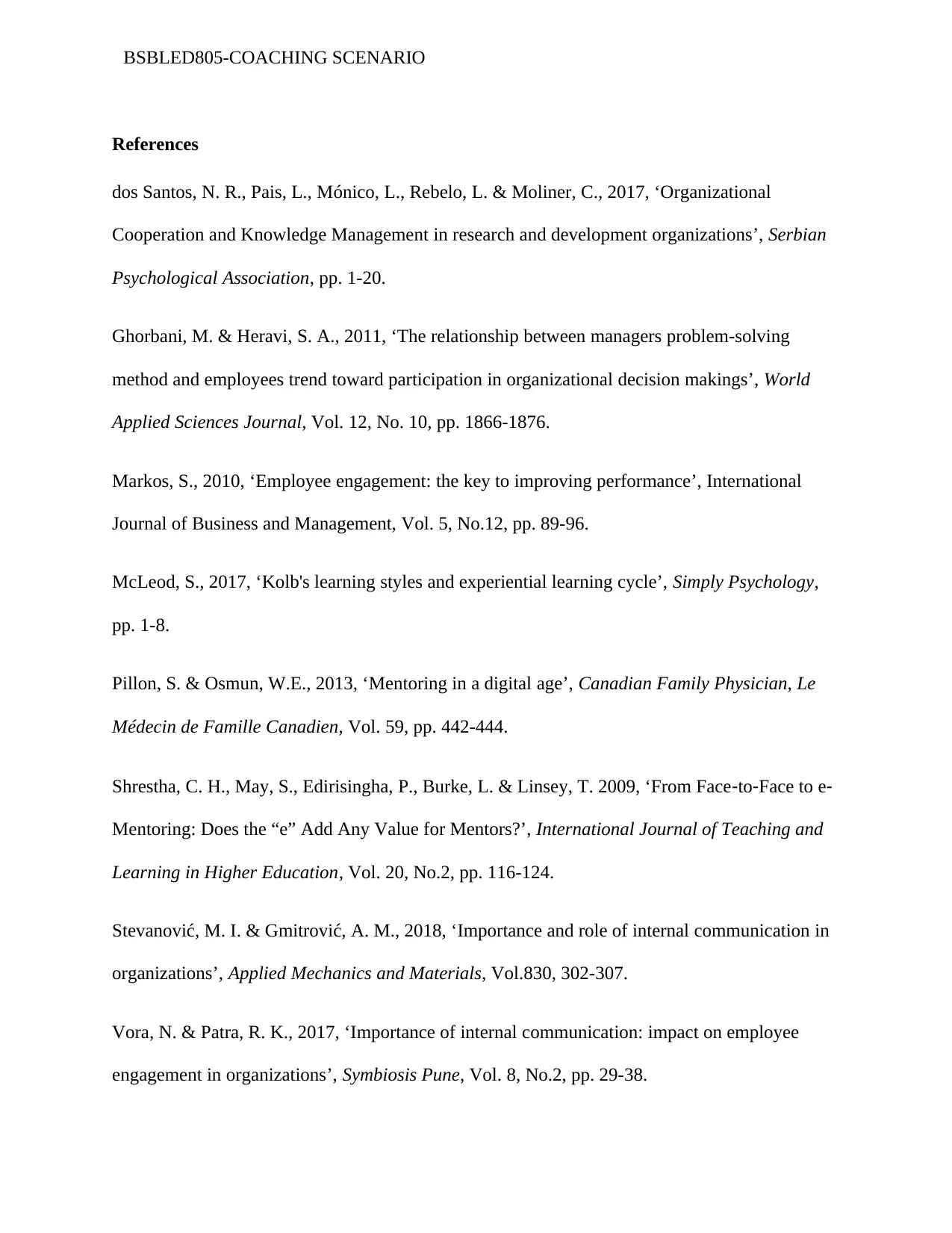
BSBLED805-COACHING SCENARIO
References
dos Santos, N. R., Pais, L., Mónico, L., Rebelo, L. & Moliner, C., 2017, ‘Organizational
Cooperation and Knowledge Management in research and development organizations’, Serbian
Psychological Association, pp. 1-20.
Ghorbani, M. & Heravi, S. A., 2011, ‘The relationship between managers problem-solving
method and employees trend toward participation in organizational decision makings’, World
Applied Sciences Journal, Vol. 12, No. 10, pp. 1866-1876.
Markos, S., 2010, ‘Employee engagement: the key to improving performance’, International
Journal of Business and Management, Vol. 5, No.12, pp. 89-96.
McLeod, S., 2017, ‘Kolb's learning styles and experiential learning cycle’, Simply Psychology,
pp. 1-8.
Pillon, S. & Osmun, W.E., 2013, ‘Mentoring in a digital age’, Canadian Family Physician, Le
Médecin de Famille Canadien, Vol. 59, pp. 442-444.
Shrestha, C. H., May, S., Edirisingha, P., Burke, L. & Linsey, T. 2009, ‘From Face‐to‐Face to e‐
Mentoring: Does the “e” Add Any Value for Mentors?’, International Journal of Teaching and
Learning in Higher Education, Vol. 20, No.2, pp. 116-124.
Stevanović, M. I. & Gmitrović, A. M., 2018, ‘Importance and role of internal communication in
organizations’, Applied Mechanics and Materials, Vol.830, 302-307.
Vora, N. & Patra, R. K., 2017, ‘Importance of internal communication: impact on employee
engagement in organizations’, Symbiosis Pune, Vol. 8, No.2, pp. 29-38.
References
dos Santos, N. R., Pais, L., Mónico, L., Rebelo, L. & Moliner, C., 2017, ‘Organizational
Cooperation and Knowledge Management in research and development organizations’, Serbian
Psychological Association, pp. 1-20.
Ghorbani, M. & Heravi, S. A., 2011, ‘The relationship between managers problem-solving
method and employees trend toward participation in organizational decision makings’, World
Applied Sciences Journal, Vol. 12, No. 10, pp. 1866-1876.
Markos, S., 2010, ‘Employee engagement: the key to improving performance’, International
Journal of Business and Management, Vol. 5, No.12, pp. 89-96.
McLeod, S., 2017, ‘Kolb's learning styles and experiential learning cycle’, Simply Psychology,
pp. 1-8.
Pillon, S. & Osmun, W.E., 2013, ‘Mentoring in a digital age’, Canadian Family Physician, Le
Médecin de Famille Canadien, Vol. 59, pp. 442-444.
Shrestha, C. H., May, S., Edirisingha, P., Burke, L. & Linsey, T. 2009, ‘From Face‐to‐Face to e‐
Mentoring: Does the “e” Add Any Value for Mentors?’, International Journal of Teaching and
Learning in Higher Education, Vol. 20, No.2, pp. 116-124.
Stevanović, M. I. & Gmitrović, A. M., 2018, ‘Importance and role of internal communication in
organizations’, Applied Mechanics and Materials, Vol.830, 302-307.
Vora, N. & Patra, R. K., 2017, ‘Importance of internal communication: impact on employee
engagement in organizations’, Symbiosis Pune, Vol. 8, No.2, pp. 29-38.
1 out of 10
Related Documents
Your All-in-One AI-Powered Toolkit for Academic Success.
+13062052269
info@desklib.com
Available 24*7 on WhatsApp / Email
![[object Object]](/_next/static/media/star-bottom.7253800d.svg)
Unlock your academic potential
Copyright © 2020–2025 A2Z Services. All Rights Reserved. Developed and managed by ZUCOL.





